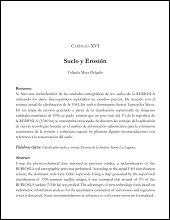APPLYING ECOLOGICAL DIVERSITY INDICES WITH ECOSYSTEM APPROACH AT ECOREGIONAL LEVEL AND PRIORITIZING THE DECREE OF NEW PROTECTED NATURAL AREAS
Autor
LUZ MARIA CRUZ GARCIA
JOSE ALFREDO ARREOLA LIZARRAGA
RENATO ARTURO MENDOZA SALGADO
PATRICIA GALINA TESSARO
LUIS FELIPE BELTRAN MORALES
ALFREDO ORTEGA RUBIO
Metadatos
Mostrar el registro completo del ítemResumen
"Uno de los principales desafíos en la priorización de las nuevas Áreas Naturales Protegidas es utilizar las herramientas apropiadas para determinar cuáles de las áreas a nivel ecorregional son las más representativas. En este trabajo utilizamos índices de diversidad ecologica (IDEs) con un enfoque ecosistémico como una herramienta para comparar las diferencias en la diversidad de ecosistemas entre las diferentes ecorregiones. Después de comparar cinco IDE en las ecorregiones costeras y marinas en el Noroeste de México, se concluye que de los cinco indices analizados para la diversidad de ecosistemas, el índice Inverso de Simpson y el índice de Hill fueron los más sensibles, considerando las tendencias de sus gráficas, las variaciones y las distancias entre sus valores, que describen la diversidad de ecosistemas entre las ecoregiones más apropiadamente. Sin embargo, para describir la riqueza y la heterogeneidad de las regiones analizadas, el índice Inverso de Simpson fue el más útil a fin de definir cuál de estas tiene la mayor diversidad de ecosistemas en estudios comparativos entre ellas y por lo tanto su prioridad para ser decretadas como nuevas Áreas Naturales Protegidas." "One of the main challenges of the new Protected Natural Area prioritization is using the appropriate tools to determine which of the areas are more representative at the ecoregional level. In this work, we used ecological diversity indices (EDIs) with an ecosystem approach as a tool to compare the differences in ecosystem diversity among different ecoregions. After comparing five EDI at coastal and marine ecoregions on Northwestern Mexico, it is concluded that out of the five indices analyzed for ecosystem diversity, the Simpson’s Inverse and Hill indices were the most sensitive ones, considering the trends of their charts, variations, and the distance between their range values, which describe ecosystem diversity more accurately among different ecoregions. However, in order to describe the richness and heterogeneity of the analyzed ecoregions, the Simpson’s Inverse index was the most useful to define which of the regions have greater diversity of ecosystems in comparative studies among them, and therefore the priority to be enacted as a new Protected Natural Area."
Colecciones
Ítems relacionados
Mostrando ítems relacionados por Título, autor o materia.
-
PROMOCIÓN DEL PERIFITON PARA EL CULTIVO DE CAMARÓN BLANCO: HACIA UNA ACUICULTURA ECOLÓGICA
DOMENICO VOLTOLINA LOBINA; JUAN MANUEL AUDELO NARANJO; MARIA DEL ROSARIO PACHECO MARGES -
Suelo y Erosión
YOLANDA LOURDES MAYA DELGADO


